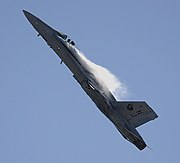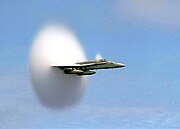Into Production

During flight testing, the snag on the leading edge of the stabilators was filled in, and the gap between the Leading edge extensions (LEX) and the fuselage mostly filled in. The gap, called the boundary layer air discharge (BLAD) slots, controlled the vortices generated by the LEX and presented clean air to the vertical stabilizers at high angles of attack. However, they also generated a great deal of parasitic drag, worsening the problem of the F/A-18's inadequate range. McDonnell filled in 80% of the gap, leaving a small slot to bleed air from the engine intake. This may have contributed to early problems with fatigue cracks appearing on the vertical stabilizers due to extreme aerodynamic loads, resulting in a momentary grounding in 1984 until the stabilizers were strengthened. Starting in May 1988, a small vertical fence was added to the top of each LEX to broaden the vortices and direct them away from the vertical stabilizers. This also provided a minor increase in controllability as a side effect.
The first production F/A-18A flew on 12 April 1980. After a production run of 380 F/A-18As (including the nine assigned to flight systems development), manufacture shifted to the F/A-18C in September 1987.
Design

The F/A-18 is a twin engine, mid-wing, multi-mission tactical aircraft. It is superbly maneuverable, owing to its good thrust to weight ratio, digital fly-by-wire control system, and leading edge extensions (LEX). The LEX allow the Hornet to remain controllable at high angles of attack. This is because the LEX produce powerful vortices over the wings, creating turbulent airflow over the wings and thus delaying or eliminating the aerodynamic separation responsible for stall, allowing the Hornet's wings to generate lift several times the aircraft's weight, despite high angles of attack. The Hornet is therefore capable of extremely tight turns over a large range of speeds.
Canted vertical stabilizers are another distinguishing design element, and among the other design characteristics that enable the Hornet's excellent high angle-of-attack capability include oversized horizontal stabilators, oversized trailing edge flaps that operate as flaperons, large full-length leading-edge flaps, and flight control computer programming that multiplies the movement of each control surface at low speeds and moves the vertical rudders inboard instead of simply left and right. The Hornet's normally high angle-of-attack performance envelope was put to rigorous testing and enhanced in the NASA F-18 High Alpha Research Vehicle (HARV). NASA used the F-18 HARV to demonstrate flight handling characteristics at high angle-of-attack (alpha) of 65-70 degrees using thrust vectoring vanes. F/A-18 stabilators were also used as canards on NASA's F-15S/MTD.
The Hornet was among the first aircraft to heavily utilize multi-function displays, which at the switch of a button allow the pilot to perform either fighter or attack roles or both. This "force multiplier" capability gives the operational commander more flexibility in employing tactical aircraft in a rapidly changing battle scenario. It was the first Navy aircraft to incorporate a digital multiplex avionics bus, enabling easy upgrades.
The Hornet is also notable for having been designed with maintenance in mind, and as a result has required far less downtime than its heavier counterparts, the F-14 Tomcat and the A-6 Intruder. Its mean time between failure is three times greater than any other Navy strike aircraft, and requires half the maintenance time. For example, whereas replacing the engine on the A-4 Skyhawk required removing the aircraft's tail, the engine on the Hornet is attached at only three points and can be directly removed without excessive disassembly. An experienced maintenance crew can remove and replace an F/A-18 engine in only a couple of hours.

The General Electric F404-GE-400 or F404-GE-402 engines powering the Hornet were also innovative in that they were designed with operability, reliability, and maintainability first. The result is an engine that, while unexceptional on paper in terms of rated performance, demonstrates exceptional robustness under a variety of conditions and is resistant to stall and flameout. By contrast, the Pratt & Whitney TF30 engines that originally powered the F-14A were notoriously prone to compressor stall and flameout under certain flight conditions.
The engine air inlets of the Hornet, like that of the F-16, are "fixed", while those of the F-4, F-14, and F-15 have variable geometry or variable ramp engine air inlets. The variable geometry enables high-speed aircraft to keep the velocity of the air reaching the engine below supersonic. This is one speed limiting factor in the Hornet design. Instead, the Hornet uses bleed air vents on the inboard surface of the engine air intake ducts to slow and reduce the amount of air reaching the engine. While not as effective as variable geometry, the bleed air technique functions well enough to achieve near Mach 2 speeds, which is within the designed mission requirements. The less sophisticated design is also more robust.

Because it was designed as a light multirole aircraft to complement the specialized F-14 and A-6 airframes, it had a relatively low internal fuel fraction. That is, its internal fuel capacity is small relative to its take-off weight, at around 23%, a fuel fraction of .23. Most aircraft of its class have a fuel fraction between .30 to .35. This situation was exacerbated by the addition of new avionics over its lifespan, further reducing the fuel fraction. This led to 330-gallon external tanks being a common sight on F/A-18s, with the centerline and inner wings stations (numbered 3, 5 and 7) being plumbed to transfer fuel.
Design evolution
In the 1990s, the US Navy faced the need to replace its aging A-6 Intruders, EA-6 Prowlers, A-7 Corsair IIs and F-14 Tomcats without proper replacements in development. To answer this deficiency, the Navy had the F/A-18E/F Super Hornet developed. Despite its designation, it is not an upgrade of the F/A-18 Hornet, but rather, a new, larger airframe utilizing the design concepts of the Hornet. Hornets and Super Hornets will serve complementary roles in the US Navy carrier arsenal, until the deployment of the F-35C Lightning II, which will primarily replace F/A-18A-D Hornets.